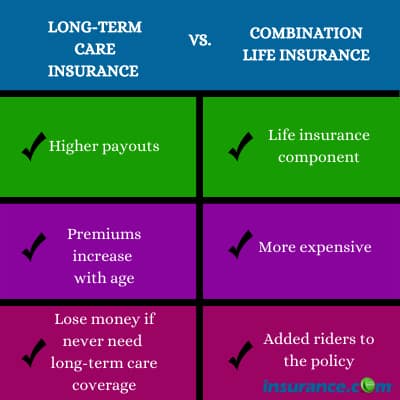- What is long-term care insurance?
- How do you get long-term care insurance?
- How much does long-term care insurance cost?
- What is combination life insurance?
- How much does combination life insurance cost?
- How do you get combination life insurance?
- Differences between long-term care insurance and combination life insurance
- What long-term care plan is right for you?
- How do people pay for long-term care?
- When can you use long-term care protection?
What is long-term care insurance?
Long-term care insurance provides funding for long-term care, including a nursing home or at-home care. 
The bad news is that there are only a handful of companies that still offer long-term care insurance. If you’re able to find a policy, you’ll pay a lot more than someone a decade ago.
The reason why fewer companies offer long-term care insurance comes down to costs:
- People are living longer while getting long-term care. That means more money being paid out by insurers.
- Fewer people are buying long-term care policies, which means fewer dollars helping pay for those collecting benefits.
How do you get long-term care insurance?
The first step is to find an insurance company that offers long-term care policies.
You’ll also need a medical exam. The insurer will decide whether you’re a risk.
Younger people have a better shot at getting approval, so it's best to buy insurance young.
How much does long-term care insurance cost?
Long-term care policies can become expensive. State regulators are concerned about the rising costs, but insurers argue the rate increases are needed to help the changing market.
Specific long-term care insurance rates vary by age, health, level of benefits and insurer. Here are 2020 (the most recent data available) annual premiums for a $164,000 policy, according to the American Association for Long-Term Care Insurance:
- Single male, age 55 -- $1,700
- Single female, age 55 -- $2,765
- Couple, age 55 -- $3,050
What is combination life insurance?
Combination life insurance is a permanent life insurance policy with a long-term care insurance rider.
This rider allows you to tap into your long-term care savings if you need it. You don’t pay taxes on it. If you don’t use it, the money will go toward a death benefit.
You can add other riders to the policy like:
- Accelerated death benefits
- Disability income
- Critical illness
Once a doctor signs off, you get a percentage of the overall death benefit for the insurance rider. An example is if you have a $200,000 life insurance policy and a rider for 3% a month for long-term care, you could tap into $6,000 a month for long-term care expenses.
How much does combination life insurance cost?
Combination life insurance isn’t cheap.
A combination life insurance policy may cost you $75,000 if you’re willing to pay one lump sum for the long-term care rider. It may cost more if you spread out the payments over a few years. So, it’s not usually an option for someone who doesn’t have money available.
How do you get combination life insurance?
Unlike long-term care insurance, many insurers offer combination life insurance. If you already have a permanent life insurance plan, you can talk to your insurer about adding a long-term care rider or changing policies.
Since it’s a permanent life insurance plan, you can also add other riders to create a policy that works for you.
Once you find a policy for you, the insurer will likely ask a series of health-related questions and you’ll probably need a medical exam. The insurer will decide about approval and your rates by the answers to those questions and the exam.
Differences between long-term care insurance and combination life insurance
There are many differences between long-term care insurance and combination life insurance. Here are a few of them:
- Combination life insurance provides permanent life insurance as well as long-term care coverage.
- Long-term care insurance is only for long-term care.
- Combination life insurance is more expensive than long-term care insurance.
- Long-term care insurance premiums increase as you age. Combination life insurance premiums are usually consistent.
- You lose any money not spent on a long-term care insurance policy.
- Long-term care insurance usually has larger payouts than combination life insurance.
What long-term care plan is right for you?
It depends on your situation, finances and what you want out of your coverage.
Here are questions to ask yourself:
- What do you want out of a policy? Do you just want long-term care coverage or the ability to transform that money into a death benefit?
- How much money do you have to spend on a policy?
- Do you already have life insurance or do you need a policy?
- Do you have beneficiaries who need a death benefit?
- Are you OK with spending higher rates for long-term care insurance as you age?
The answers to those questions will help you figure out what’s a better choice.
Then, your next step is to talk to a financial planner. Create budgeting and financial modeling to figure out whether you need long-term care protection.
If you feel you need it, shop around and get quotes from multiple companies. You may want to price both long-term insurance and combination life insurance to see which avenue makes sense for you.
How do people pay for long-term care?
Medicare usually doesn’t cover long-term care. Medicare covers your medical expenses, but when it comes to long-term care, you’re generally on your own.
One exception is people who qualify for Medicaid. Medicaid will pick up a portion of the costs of long-term care.
However, if you don’t qualify for Medicaid, you’ll need to figure out a way to pay for long-term care. That could result in your family selling your home to help pay for nursing home care.
Long-term care can cost thousands a month, so having a plan to pay for it is important.
When can you use long-term care protection?
A doctor must diagnose you with cognitive impairment or deem you incapable of performing at least two of six daily living activities:
- Bathing
- Continence
- Getting dressed
- Eating
- Toileting
- Transferring (moving to and from a bed or a chair)
Once a doctor signs off, you’re able to submit claims for your long-term care. Once you get the OK for long-term care insurance, you, your family or your representative can file claims.




